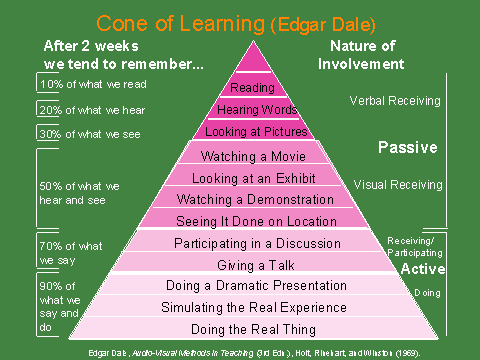

Interactive Distance Learning

The Importance of Interaction
The reason for emphasising interaction is its strong influence on knowledge retention. The Cone of Learning (Dale) chart as shown, highlights the importance of giving students an active role in the learning process. It is evident that having students actively involved, by participating in activities and discussions, their expected level of retention will increase from 50% (passive receiving) to 90% (active participation).
It is for these reasons that REACT has been specifically designed to incorporate rich, dynamic multimedia tools to not only allow but encourage enjoyable interaction during lessons.

Sense of Community
Educating people generally and children specifically in remote locations is very challenging for the children, their families and their teachers and has become an increasing focus for researchers.
It has often been noted that learning at a distance makes it difficult to form a 'Sense of Community' amongst participants so that they do not feel removed from the activities, their teachers and their classmates. REACT is designed to have the highest quality audio and video to enable teachers and students to actively participate as if in the real classroom. Students have access to all the tools in the software to maximise their involvement and contribution. Students are also provided with the option to personalise their attendance by creating their own 'profile' (image & name) in the class list which can be changed as often as desired.
The concept of distance learning is that participants are usually separated by distance and/or time. There are two main types of distance learning concepts.
-
Synchronous: This describes learning activities in which the students and teachers are separated by distance, but not by time.
-
Asynchronous: This describes learning activities in which the students and teachers participate at different times.
REACT is a synchronous e-Learning tool that permits teachers and students to attend a real-time virtual classroom irrespective of how geographically dispersed they may be. REACT offers many features and tools which facilitate interaction and collaboration between all participants making the virtual classroom as close to the real thing as this innovative technology can provide.

Lip-Synchronisation
Lip-Synchronisation or lip-sync(h) in abbreviated form is the matching of lip movements with spoken or sung vocals. This is considered to be essential for the teaching of languages and where students may have hearing difficulties and rely on lip-reading to assist their hearing.
Most virtual classroom softwares do not consider this and hence students are often faced with a loss of lip-sync or lip-sync error.
The good news is that REACT has been developed to ensure lip-sync across various networks including satellite networks with their inherent issue of latency or delay.

Now it's up to the Imagination!
REACT provides the tools to enable maximised interaction and collaboration and to permit the development of a 'Sense of Community' amongst teachers and students and between students themselves.
Through a range of dynamic capabilities now at their fingertips, teachers and students are provided with learning options limited only by their imagination.